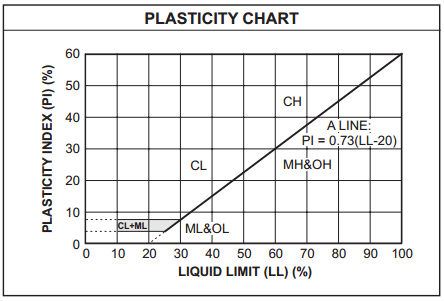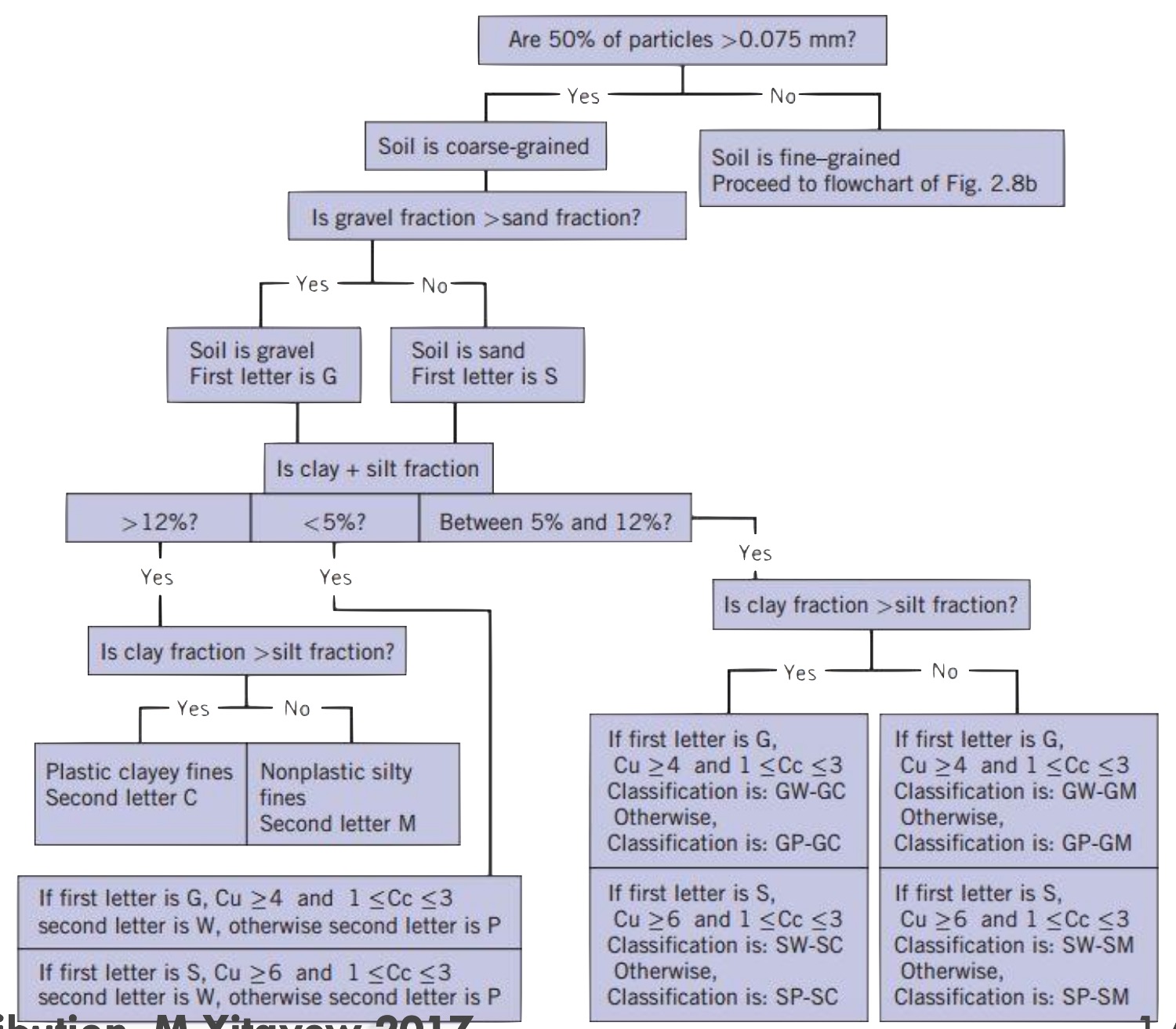How to Read Uscs Classification When Fines Are Non Plastic

Unified Soil Nomenclature System (USCS)
The Unified Soil Classification System is based on the airfield soil classification system developed by Casagrande during World War Two. With some modification it was jointly adopted by several U.Due south. regime agencies in 1952. Additional refinements were made and it is currently standardized as ASTM D 2487-93. It is used in the U.South. and much of the world for geotechnical work other than roads and highways (For which AASHTO Soil Classification is used). In the unified system soils are designated by a two-letter symbol: the first identifies the main component of the soil, and the second describes its grain size or plasticity characteristics. For example, poorly graded sand is designated SP and low plasticity dirt is CL. Five showtime-letter of the alphabet symbols are used:
- Thousand for gravel
- S for sand
- M for silt
- C for clay
- O for organic soil
Clean sands and gravels (having less than 5% passing the No. 200 sieve in Sieve Analysis) are given a second letter P if poorly graded or W if well graded. Sands and gravels with more than 12% past weight passing the No. 200 sieve are given a second letter G if the fines are silty or C if fines are clayey. Sands and gravels having between 5 and 12% are given dual classifications such as SP-SM. Silts, clays, and organic soils are given the second alphabetic character H or L to designate high or depression plasticity. The specific rules for nomenclature are summarized as follows and described in detail in ASTM D 2487.
- Organic soils are distinguished past a dark-brownish to blackness color, an organic scent, and visible fibrous affair.
- For soils that are not notably organic the first pace in classification is to consider the percentage passing the No. 200 sieve.
- If less than 50% of the soil passes the No. 200 sieve, the soil is coarse grained, and the first alphabetic character will be K or South;
- if more than 50% passes the No. 200 sieve, the soil is fine grained and the first letter will be M or C.
In Unified Soil Classification Arrangement, for coarse-grained soils, the proportions of sand and gravel in the coarse fraction (non the total sample) determine the showtime letter of the classification symbol. The coarse fraction is that portion of the total sample retained on a No. 200 sieve. If more than one-half of the coarse fraction is gravel (retained on the No. 4 sieve), the soil is gravel and the offset letter symbol is G. If more than half of the coarse fraction is sand, the soil is sand and the first letter symbol is Due south. For sands and gravels the second letter of the nomenclature is based on gradation for clean sands and gravels and plasticity of the fines for sands and gravels with fines.
For clean sands (less than 5% passing the No. 200 sieve), the USCS classification is well-graded sand (SW) if C ≥ 6 and ane £ Cc £ three. Both of these criteria must be met for the soil to be SW, otherwise the nomenclature is poorly graded sand (SP). Clean gravels (less than 5% passing the No. 200 sieve) are classified besides-graded gravel (GW) if Cu ≥ iv and one £ Cc £ 3. If both criteria are non met, the soil is poorly graded gravel (GP). For sands and gravels where more than 12% of the total sample passes the No. 200 sieve, the soil is a clayey sand (SC), clayey gravel (GC), silty sand (SM), or silty gravel (GM).
The second letter is assigned based on whether the fines classify as clay (C) or silt (Thousand) as described for fine-grained soils below. For sands and gravels having between 5 and 12% of the full sample passing the No. 200 sieve, both the gradation and plasticity characteristics must be evaluated and the soil is given a dual classification such as SP-SM, SP-SC, GW-GC, etc. The starting time symbol is always based on gradation, whereas the second is always based on plasticity. For fine-grained soils and organic soils, classification in the unified system is based on Atterberg limits adamant by the fraction passing the No. 40 sieve. The liquid limit and plasticity alphabetize in the Unified Soil Nomenclature Organization are adamant and plotted on the plasticity chart. The vertical line at LL = 50 separates high-plasticity soils from low-plasticity soils. The A-line separates clay from silt. The equation of the A-line is

The U-line is not used in Unified Soil Classification System but is an upper boundary of expected results for natural soils. Values plotting above the U-line should exist checked for errors. Inorganic soils with liquid limits below 50 that plot higher up the A-line and have PI values greater than vii are lean clays and are designated CL; those with liquid limits to a higher place 50 that plot to a higher place the A-line are fat clays and are designated CH. Inorganic soils with liquid limits below 50 that plot below the A-line are silt and are designated ML; those with liquid limits above l that plot below the A-line are elastic silts and are designated MH.
The plasticity chart has a shaded area; soils that plot in this surface area (above the A-line with PI values between four and 7) are silty clay and are given the dual symbol CL-ML. If the soil under consideration is the fines component of a dual classified sand or gravel, the soil is classified as SM-SC or GM-GC. Soils with sufficient organic contents to influence backdrop that have liquid limits below 50 are classified every bit OL; those with liquid limits higher up l are classified equally OH. Soils that are predominantly organic, with visible vegetable tissue, are termed peat and given the designation Pt.
Source: https://www.aboutcivil.org/unified-soil-classification-system
0 Response to "How to Read Uscs Classification When Fines Are Non Plastic"
Post a Comment